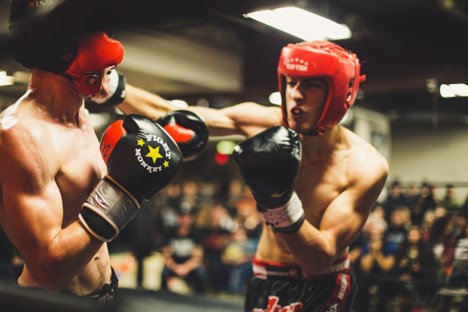Beware the foe who feels no pain
– by Wilson Merrell, PhD Candidate in Social Psychology at the University of Michigan
Insensitivity to pain is a valuable asset when it comes to physical altercations. From ancestral conflict between warring coalitions to boxers in a 12-round fight, individuals who are relatively insensitive to pain are better able to persist, and more likely to succeed, in their respective conflicts compared to individuals who are sensitive to pain. What are the implications of such a tactical advantage when it comes to sizing up potential antagonists? This was the primary question my co-authors and I set out to answer in our recent paper published in Evolution & Human Behavior. Theoretically, we turned to the Formidability Representation Hypothesis, which posits that the various assets and liabilities a target possesses are summarized into a single size- and strength-based representation. Because assessments of size and strength have historically and phylogenetically been primary determinants of fighting ability, this summary facilitates decisions about whether to fight or flee in the face of physical conflict.
This hypothesis has a host of empirical support. For example, people armed with a weapon, something that would make them a more formidable adversary, are represented as larger and stronger than people who are unarmed. Conversely, someone suffering from a broken leg is a less formidable adversary and, correspondingly, is represented as smaller and weaker than a fully healthy person. Looking at pain insensitivity through the lens of the Formidability Representation Hypothesis leads to a relatively simple prediction: people who are insensitive to pain, and thus more able to persist and succeed in physical conflict, will be represented as physically larger and stronger than people who are sensitive to pain.
Testing the link between pain insensitivity and physical size
We tested this causal link in our first two studies with a sample of just over 650 U.S.-based participants from online crowd work platforms. Participants read about a man who was either insensitive to pain (someone doesn’t feel pain strongly when he gets a shot at the doctor’s office, stubs his toe, or has a paper cut) or sensitive to pain (someone who feels pain strongly during all of those events). We next asked them how physically formidable they thought this man was—they judged his height, muscularity, and overall size. As we expected, the man who was insensitive to pain was judged to be taller, more muscular, and overall larger than the man who was sensitive to pain. In line with other predictions derived from the Formidability Representation Hypothesis related to mental representations of potential foes, the pain-insensitive man was also deemed to be more aggressive, higher status, and a bigger risk-taker than the pain-sensitive man.
Building on this foundation, we next tested the reverse relationship between pain sensitivity and physical characteristics: would more formidable people be judged as more insensitive to pain? We reasoned the answer would be “yes” given the tendency to minimize costly errors—confronted with a formidable foe, it is safer to erroneously assume they are insensitive to pain than to erroneously assume they are sensitive to pain. Our final study tested this reasoning with an additional U.S. sample of around 300 people from an online platform. Here, participants viewed a man holding an object that could be used as a weapon (like a kitchen knife—enhancing his formidability), or an object that could not be construed as a weapon (like a spatula—decreasing his formidability). Men holding knives or garden shears were judged to feel less pain when they experienced things like hitting their head on a piece of furniture than men holding spatulas or watering cans. Independently, and in replication of previously demonstrated results, the former were also seen as angrier than the latter.
What’s next?
This intimate connection between pain insensitivity and physical formidability suggests a host of future theoretical directions. In the context of cultures that face high levels of physical conflict, stoicism in the face of painful rituals may act as formidability signals that bolsters one’s reputation, especially if permanent physical evidence of this ritual exists. Our results may also provide an additional level of explanation that could help advance understanding of contemporary societal inequities. For instance, situations with high levels of group-based inequality, like the healthcare and criminal justice systems, are also social contexts where individuals in power are often tasked with making decisions based on assessments of pain, size, and threat. Consider that Black men in the United States are stereotyped as larger (exacerbating excessive use of force from police) and more insensitive to pain (leading to systematic undertreatment for pain) than White men. Our findings suggest that these harmful judgments about pain insensitivity and size could compound one another. Future research would benefit from examining mental representations of pain insensitivity, physical size, and perceived threat in these specific contexts to mitigate harmful social outcomes.
Read the original paper: Fessler, D.M.T., Merrell, W., Holbrook, C., & Ackerman, J. (2023). Beware the foe who feels no pain: associations between relative formidability and pain sensitivity in three U.S. online studies. Evolution and Human Behavior, 44(1), 1-10.
(Photo credit: Hermes Rivera)



